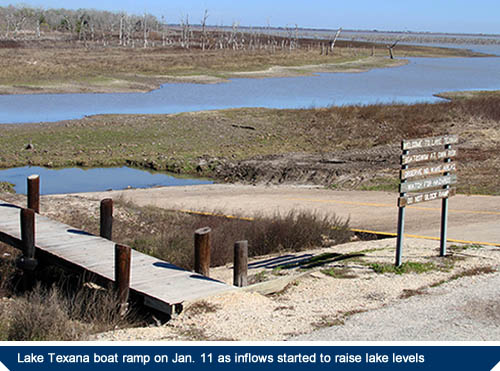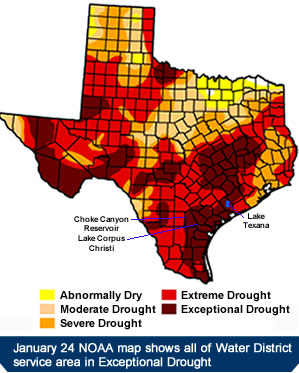January 28, 2012
Strong winter frontal passages in January brought welcome rainfall to the Navidad River basin which stretches north from Lake Texana to Lavaca, Colorado and Fayette counties.
Lake Texana water levels dipped to a historically low 35.7% of capacity on January 8th. Rains on January 9th caused flooding in Houston and provided enough runoff in the Lake Texana watershed to raise the lake by 2 feet over the following week. A second rainfall event on January 25th raised the lake level by another 2.5 feet. By January 28th the lake level was above 50% capacity for the first time since August 29th. [UPDATE: Additional inflows pushed Lake Texana to above 58% by February 16th.]
Prior to these two events there had been virtually no water inflows from the Navidad River and other tributaries in the past year, one of the driest on record in Texas. Until 2011 Lake Texana levels had never been below 58% in the decades since the reservoir became fully operational in the mid 1980s.
About one half of the raw water used by the San Patricio Municipal Water District (SPMWD) to supply municipal and industrial customers comes from Lake Texana which is located 110 pipeline miles to the northeast in Jackson County.
Customers depending on Lake Texana include the City of Point Comfort, the Formosa Plastics Corp. complex at Point Comfort, Inteplast Group at Lolita, Corpus Christi, South Texas Water System and the SPMWD. Customers in the Point Comfort area have no alternative water supply. .
The SPMWD staff began work in late summer to implement raw water system modifications that will allow a shift to a higher percentage of water from the Nueces River in case Lake Texana water is not available in the coming years.
Minimal inflows, very high evaporation rates and high demand from customers served by the regional system have steadily lowered the amount of water in storage at Lake Corpus Christi and Choke Canyon this year. Total storage for the system slipped below 53% of capacity in late January. 
The City of Alice, which draws water directly from Lake Corpus Christi, began implementing its drought contingency plan in November. The City of Rockport has standing voluntary conservation rules in place.
EXTREME DROUGHT
"Exceptional" drought conditions continue over the SPMWD service area and most of the Nueces River and Navidad River watersheds. Burn bans remain in effect in all area counties and fires in dry vegetation continue to be a problem.
The upcoming agricultural planting season in the Coastal Bend remains bleak with very low soil moisture levels. Additional rains will be needed for crops to survive.
In other parts of Texas the drought has eased somewhat. The area from Dallas-Fort Worth north to the Red River is he only area where rainfall has been adequate to change conditions.
Weather forecasters say that with La Niña locked in place the drought conditions will persist at least through the spring months. Every La Niña on record since 1900 has resulted in below-normal rainfall for the Southwest U.S.
WATER MANAGEMENT
By contract Water District customers must seek to comply with the Drought Management Plan adopted by the City of Corpus Christi which manages the region’s water supply system. The plan is tied to the combined amount of water in storage in Choke Canyon and Lake Corpus Christi. It has triggers at 50%, 40% and 30% of capacity. When the reservoir system storage drops below 50% of total system capacity, the local water provider will issue a public notice to inform water users to take greater voluntary conservation measures.
When capacity drops to 40% water providers will implement mandatory restrictions including time of day outdoor watering restrictions. Residents and businesses will be restricted from using water for irrigation of vegetation between the hours of 10:00 a.m. and 6:00 p.m. Under the 40% restrictions no person may: (1) allow water to run off from yards or plants into gutters or streets, (2) allow defective plumbing in a home or business to remain unaddressed or (3) allow water to flow constantly through a tap, hydrant, valve, or otherwise by any user of water connected to the municipal system.
At 30% of reservoir capacity residential lawn watering will be sharply restricted to specific days in an effort to reduce demand further.








